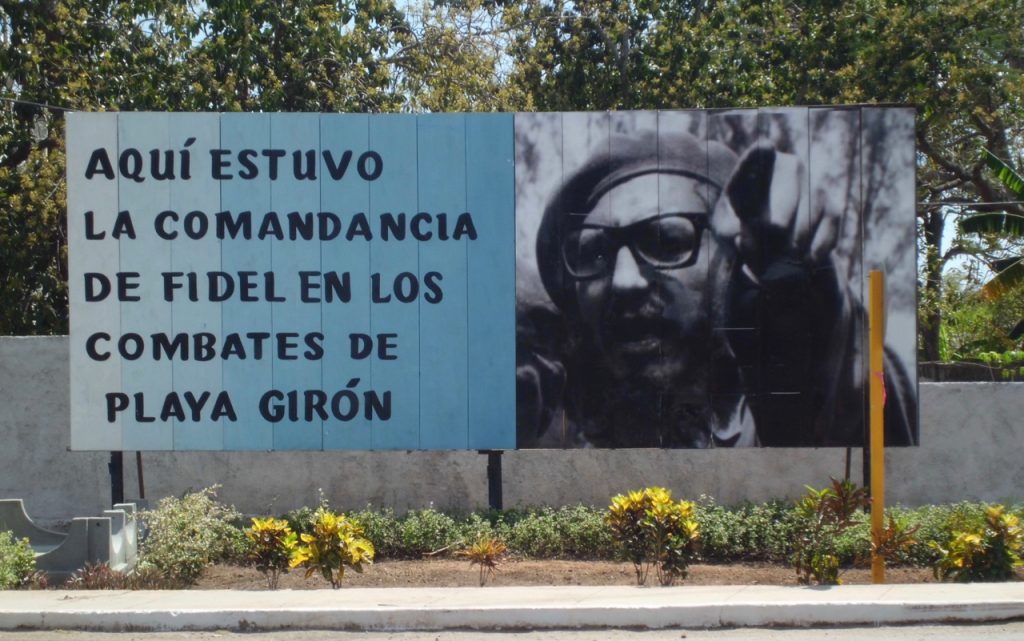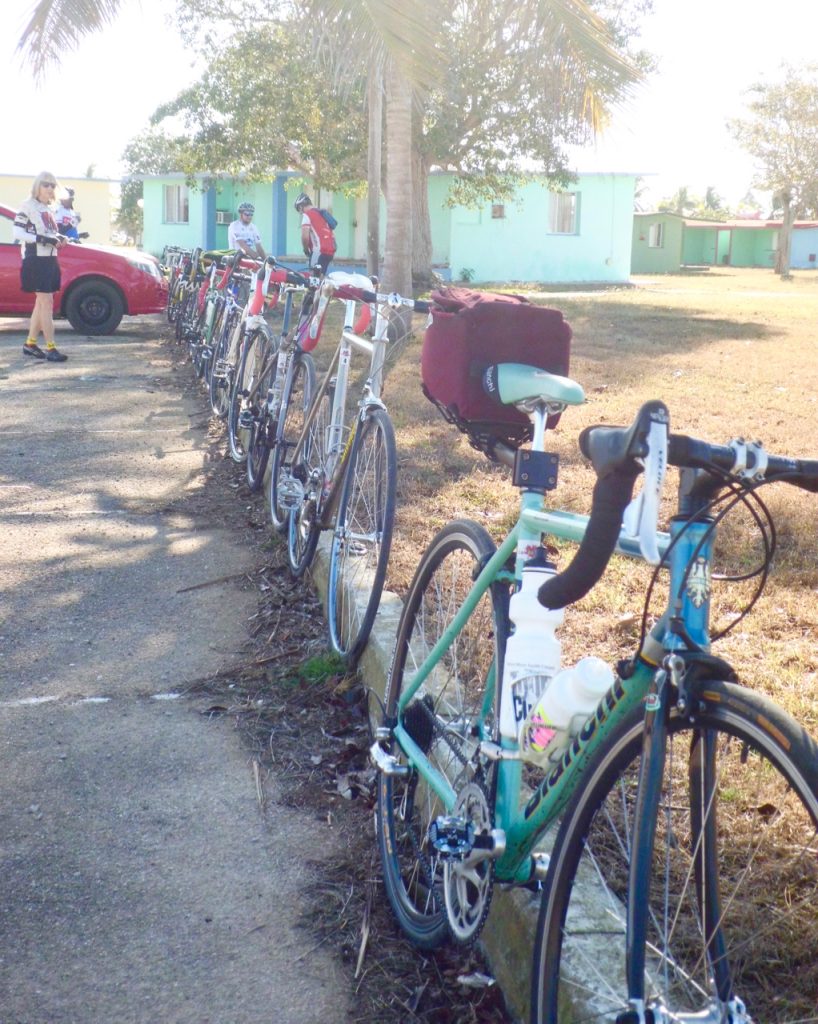After our tour of Cienfuegos, we hopped on our bikes just outside of town, and began a three hour, 85 kilometer cruise heading towards Playa Giron. Most of the ride was across a desolate swampy plain, along a nearly deserted road barely the width of two trucks. Cotton-ball cumulus clouds surrounded us, but the sun shone relentlessly, with temperatures into the low 30s (nearly 90F). By this time, despite daily applications of sunscreen, my forearms were getting a deep, crinkly brown, tender to the touch. Among the many items I did not bring, I own a pair of thin white nylon arm “coolers”, which could have served as superb sun shields. In desperation, I turned to the pair of compression calf sleeves I’d worn on the flights over. Inside out, they looked a bit like a fluffy tuxedo shirt under my cycling kit.
I spent much of the day riding with the “boys” (a group of 60-something ex-bike racers and endurance athletes), but the bleakness of the road and balmy air conspired to drop me off the back after after 15-30 minutes. I’d catch up every time we re-started, but much of the time, it was just me, the donkey carts, a few pedestrians, an old Lada or two, and the occasional truck bus crammed with passengers.
We rode through San Blas, headed towards Playa Giron. The final 15 miles were due south towards the Sea. About 30 minutes out of Giron, we began to see sandstone-red blotches atop the tarmac, about 4 or 5 inches across, looking a lot like discarded bubble gum was which had been spit out and run over by endless vehicles.
We pulled into a small outdoor café and gathered under the palapa, sharing generic colas and Bucaneros (Cuba is one of the few places on earth you won’t find Coke for sale).
“What were those red blobs we’ve been riding over?” someone asked.
“They look like chewing gum somebody spit out, but they’re too big,“ I ventured.
“No, I think those are crabs,” someone else offered.
“Crabs?”
“Yeah, I read they grow all over the beach around the bays in southern Cuba. They have to go inland to lay their eggs or something, or maybe that’s where they make their babies, I forget. Anyway, there are so few cars and trucks, they haven’t had enough selection pressure to keep them out of harm’s way, and they keep getting smashed.”
“Huh. Crabs. I thought this was the Bay of ‘Pigs’.”
The Bay of Pigs. To those of us of a certain age, this was a legendary fiasco. After Castro took control of the country in January, 1959, he was at first embraced by some in our country as a democratic savior for the Cuban people, overthrowing the repressive dictator Batista. Over the next year or so, as more middle and upper class Cubans fled their country for Miami, it became apparent that he had meant what he said about changing the power structure on the island. More and more firms were nationalized, houses of the rich were seized, large landholdings were absorbed into government control. The ex-patriates descending on Florida included some who wanted to “take back” their country. They looked to Castro himself for their inspiration. Fidel and a small band of rebels had fled the country after an ignominious defeat in 1953, ending up in Veracruz, Mexico. They purchased a small boat, the “Granma”, overloaded it with fighters and supplies, and barely escaped into the mountains when they landed on the island’s southern shores several years later.
When President Eisenhower recognized the change in Castro’s political tone, he authorized the CIA to join forces with Florida-based anti-Castro groups, and a fighting force was assembled, trained, and eventually sent to Cuba by President Kennedy in April of 1961. They landed in the Bahia de Cochinos, and the rest, as they say is history.
At the southern end of the Bay, near our seaside hotel in Giron, the Cuban government has proudly established a museum dedicated to telling their side of the story. Several tanks and a propeller plane flank the entrance. Alejandro assembled our little peloton, and urged us to visit the place. I shuddered at the thought, and stayed outside.
Castro’s revolution was founded in part on a belief that the United States wanted to subjugate the Cuban people, and supported the Batista regime as it battled against the rebels. It was Castro’s belief that the US government needed a pliable island government to enable American corporations to control the Cuban economy for their own benefit, through agriculture and tourism. The small number of well-connected rich did very well, at the expense of most of the populace, with the bulk of profits ending up offshore to the north.
Thus, the US was depicted as a foreign enemy of the Cuban people. The foiled invasion in the Bay of Pigs, coming early in the Castro regime, served to cement that view with actual proof of the US intentions towards the new Cuban government. Ever since, it has held a solemn place in the hearts of true believers there, much as, say, the War of 1812, where our national anthem was penned, has in ours.
Eventually, I rode back to the hotel parking lot, and helped Juan and a few other resistors line up the bikes for the group‘s eventual return. We planned to head north along the Bay that morning, to meet up in Playa Larga, and a promised alligator farm.
(To Be Cont’d)



